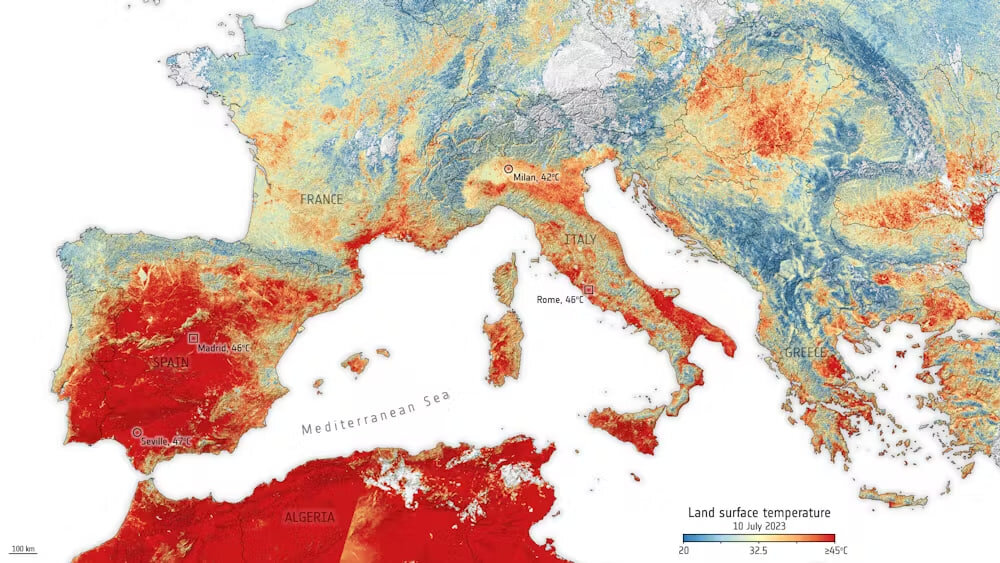Heat aggravated by carbon pollution killed 50,000 in Europe last year: study

Hot weather inflamed by carbon pollution killed nearly 50,000 people in Europe last year, with the continent warming at a much faster rate than other parts of the world, research has found.
The findings come as wildfires tore through forests outside Athens, as France issued excessive heat warnings for large swathes of the country, and the UK baked through what the Met Office expects will be its hottest day of the year.
Doctors call heat a “silent killer” because it claims far more lives than most people realise. The devastating mortality rate in 2023 would have been 80% higher if people had not adapted to rising temperatures over the past two decades, according to the study published in Nature Medicine.
Elisa Gallo, an environmental epidemiologist at ISGlobal and lead author of the study, said the results showed that efforts taken to adapt societies to heatwaves had been effective.
“But the number of heat-related deaths is still too high,” she warned. “Europe is warming at twice the rate of the global average – we can’t rest on our laurels.”
Heatwaves have grown hotter, longer and more common as people have burned fossil fuels and destroyed nature – clogging the atmosphere with gases that act like a greenhouse and heat the planet. Globally, 2023 was the hottest year on record, and scientists expect 2024 to soon take its place.
Researchers have found that cooler countries in Europe such as the UK, Norway and Switzerland will face the greatest relative rise in the number of uncomfortably hot days. But the absolute death toll will continue to be greatest in southern Europe, which is better adapted to hot weather but more exposed to scorching temperatures.
The scientists found heat-related mortality in 2023 was highest in Greece, with 393 deaths per million people, followed by Italy with 209 deaths per million and Spain with 175 deaths per million.
On Monday firefighters in Greece battled wildfires outside Athens which forced authorities to evacuate several suburbs in the capital and a children’s hospital. Repeated heatwaves had dried out the surrounding forest and turned trees into tinder.
In 2003, a heatwave killed 70,000 people across the continent and sent officials scrambling to save lives by setting up early warning systems and prevention plans. But nearly two decades later, the death toll from the record-breaking heat in 2022, which claimed more than 60,000 lives, left researchers wondering how effective the measures had been.
The scientists modelled the effects of heat on health for different time periods since the turn of the century and estimated last year’s death toll to be 47,690. They found the mortality rate would have been 80% greater if the temperatures of 2023 had hit in the period 2000–2004 than in the pre-pandemic reference period 2015-2019. For people over the age of 80, the heat would have proven twice as deadly.
Dominic Royé, the head of data science at the Climate Research Foundation, who was not involved in the study, said the results were consistent with published studies. He added that there was a need to better monitor the effects of heat on groups most at risk, as well as the implementation of plans to prevent deaths.
“We monitor temperature very well, but not health impacts in the same way,” said Royé. “Social adaptation to rising temperatures has played a crucial role in preventing mortality in Europe but remains insufficient.”
Scientists say that governments can keep people safe from heatwaves by designing cool cities with more parks and less concrete, setting up early warning systems to alert people to imminent danger, and strengthening healthcare systems so doctors and nurses are not pushed into overdrive when temperatures soar.
But individual actions like staying indoors and drinking water also have powerful effects on death tolls. Checking in on older neighbours and relatives who live alone can spell the difference between life and death.
Dr Santi Di Pietro, an assistant professor of emergency medicine at the University of Pavia, said his colleagues were treating more patients a day than they did in early January during the flu season.
Heatwaves must be tackled at all levels, he said, but people could take “simple measures” to protect themselves and their loved ones. These included avoiding the sun during the hottest hours of the day, seeking shade when outside and swapping alcohol for water.
“As obvious as it may sound, drinking water is paramount to prevent dehydration,” he said. “Elderly people often do not perceive thirst, so we should keep an extra eye on them.”
More work is needed to adapt to climate change and mitigate the rise in temperatures, said Gallo. “Climate change needs to be considered as a health issue.”
(source: Guardian)
Leave a Comment